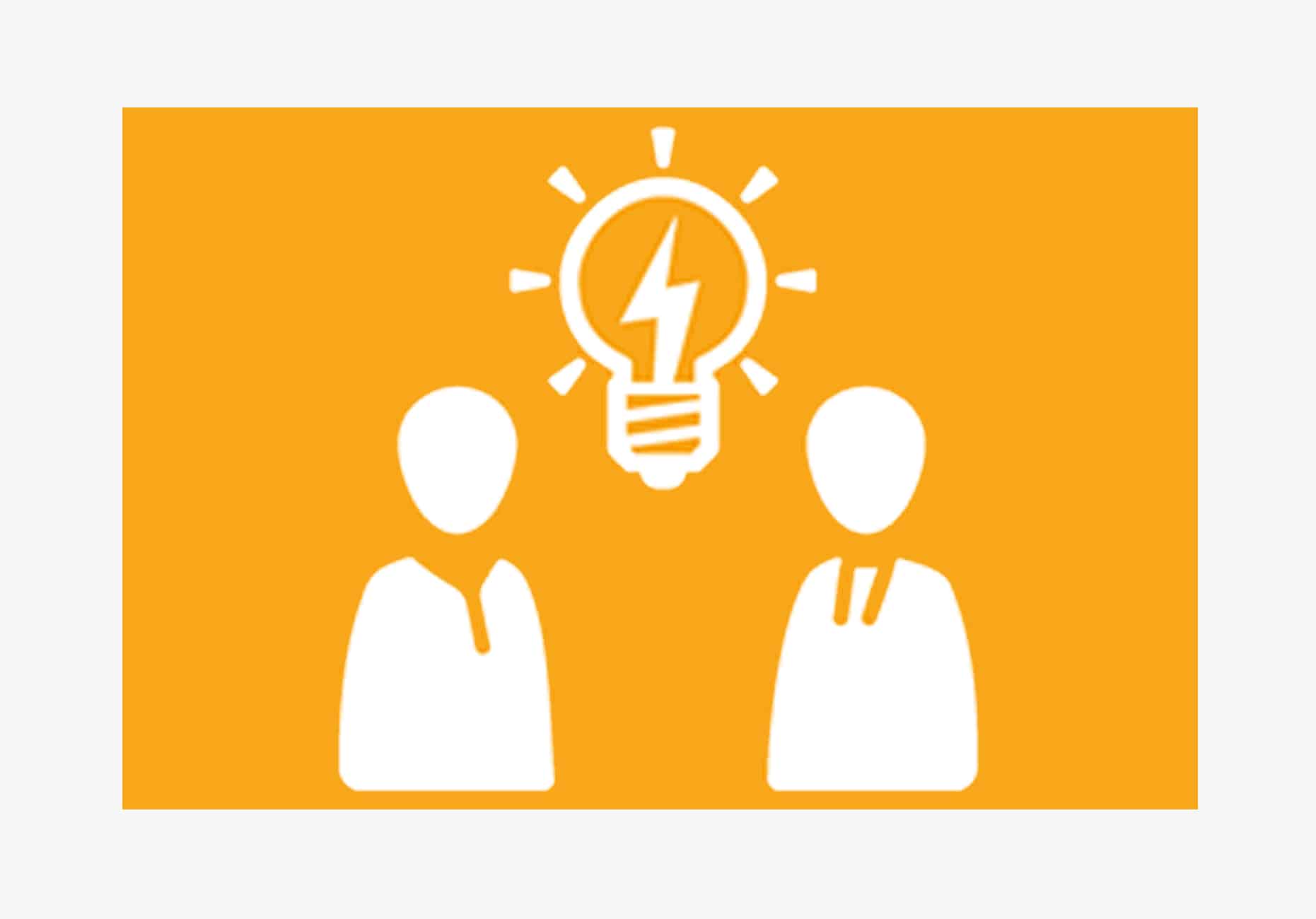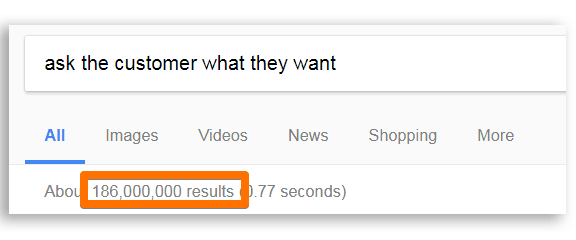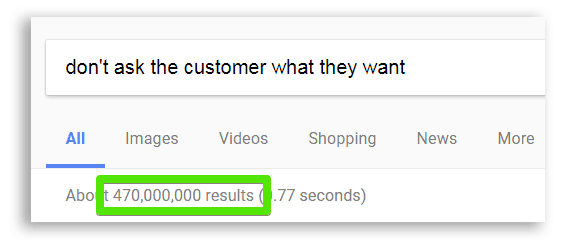Step one, ask your customers what they want. Step two, give it to them. Step three, let the profits roll in. If this summarizes your understanding of market research, you are dead wrong.
Since the start of ecommerce way back in 1994, entrepreneurs and marketers have followed these three common-sense steps, or some variation on them. In actuality, these steps lead you away from understanding customers’ true desires, and profiting as a result.
The reason for this, the fatal flaw of most feedback-driven marketing, is that customers don’t actually know what they want—and are horrifically bad at accurately reporting their desires.
To get around this flaw, instead of asking them what they want, you have to start by asking them what they don’t want.
It’s an odd concept to wrap your noodle around. But consider the status quo as the alternative. Whether it’s a one-person Shopify store or the founder of a business that survived the Dot Com Bubble Burst, the assumption about feedback-driven marketing is the same:
“Ask the customer what they want, then give it to them.”
There’s only one problem with this idea—and the free survey templates that digital businesses send to their customers based on it.
Customers Don’t Actually Know What They Want
Think for a moment about the surveys you’ve seen pelting your own inbox like golf ball-sized hail on a rickety tin roof.
“Would you use our product again?”
“Uh. . .sure? If I remember it. . .”
“How would you rate your recent experience with us?”
“7? 8 maybe? WTF do these numbers mean?”
Then we see the granddaddy of clever survey questions:
“Would you buy XYZ new product if we offered it?”
Answers to none of these questions can be trusted, but especially that last one. That’s a quirk about us humans, you see—we just plain suck at self-reporting.
To boot, we’re frequently wrong when predicting our own behavior, even when it comes to simple decisions like the small businesses we’ll frequent in the future.
According to research by statisticians Thomas D. Cook and Donald T. Campbell, customers responding to a survey “tend to report what they believe the researcher expects to see” or even “what reflects positively” on them.
In other words, if you ask, “What do customers want?” and they tell you—don’t spend a dime of your R&D budget building it.
Steve Jobs put it this way:
It’s not the customer’s job to know what they want.
Fortunately, as surveying has become easier thanks to software like SurveyMonkey, many online entrepreneurs have realized that questions beginning with the words “would you” probably don’t make sense in a customer feedback survey question.
And I do mean many online entrepreneurs have realized this. Just compare the Google search results of “ask the customer what they want” to “don’t ask the customer what they want.”
This should be a wake-up call to entrepreneurs still clinging to the old approach. They’re being left behind. It also raises a different question: “What should we do instead?”
Leaving that question unanswered is as much of a mistake as asking these wrong questions. According to business storytelling expert Allie Decker, “As an entrepreneur, your target audience is the lifeblood of your business, and it will not succeed if you don’t know them.”
So you can’t simply give up on understanding your audience. You have to find a better way. If asking what customers want is the surefire way to receive one misleading answer after the next, try the exact opposite.
Ask Customers What They Do Not Want
A few years ago, the founder of a business networking association approached me to talk marketing. Our consultation turned into a venting session in which he cussed out every salesperson on his staff.
While he had gallivanted across America on a two-week honeymoon with his new bride, his regional salesforce managed to close zero new business. Rather than dig into the numbers like New Contacts Rate or Cost Per Sales Qualified Lead, I followed a hunch: This business owner has a much deeper problem on his hands than poor sales figures.
“The fact that the sale doesn’t happen without you interacting with the prospect personally tells me something,” I responded. “It’s your personality and passion for this business that drives conversions. You probably had brand collateral and word-for-word scripts for your salesforce to use when booking appointments and making contacts, right?”
He nodded in agreement.
“What I’m getting at, is that your company’s messaging probably doesn’t communicate what you do when you’re speaking with a prospect one-on-one.” I pointed right at his chest. “You are emotionally compelling as the business owner, but your business’ value proposition on its own is not.”
His arms hit the table. He gave me a look I would’ve expected if I’d just told him we struck oil in his backyard.
“Emotionally compelling,” he repeated the words like it was a password he might forget. “That’s what I want! My business has to be able to stand on its own two feet and create customers when I’m not personally part of the process.”
Armed with the experience of feedback-driven marketing done right, I pitched the idea of surveys—but not the “What can we do to better serve you?” type.
Surveys Based on the Customer Journey
The Customer Journey is the concept that a certain percentage of your target market has no idea you exist yet (Awareness Stage), a certain percentage doesn’t have a clue why they should choose you (Consideration Stage), and a certain percentage is ready to buy today (Action Stage).
Over the following days, we created a focus group made up of 30 customers who either had the highest Customer Lifetime Value to the company or had referred the most new business (“Evangelists”). We asked them a mix of questions that applied to each of the three stages of their customer journeys.
To craft an emotionally compelling message that turned a cold Prospect into a red-hot Sales Qualified Lead, I focused the surveying on what they didn’t want.
For instance, I asked about the fears and anxieties that motivated them to become customers in the first place. Rather than turn this article into a long-winded case study, here is a list of several questions I used within the focus group. Repurpose these for your own digital business.
Note that the language always relates to solving a problem, which is why any business exists in the first place.
Awareness Stage Questions
- Before you knew about us, what did you do to ? Was there anything you didn’t like about that solution?
- Why was it a priority to rather than put it off until later? What would have happened if you kept putting it off?
- Knowing what you know now, what decisions would you have made differently when choosing a solution to ?
Consideration Stage Questions
- What was the hardest part about finding the right solution? What frustrated you about the search?
- When you first started looking up , what were your absolute “must haves”? What red flags did you watch out for?
- What preconceived beliefs did you have about businesses in ? How are we different?
- Is there anything you hate about businesses in , based on past experiences or word-of-mouth?
Action Stage Questions
- Fill in the blank, “I chose your company because ___.” Why was that important to you?
- Do you feel like this was a good decision? Why or why not?
- You hiring us resulted in . What does this offer you that you wouldn’t have otherwise had?
- What do you think would look like now if you hadn’t chosen to ?
I call these “Immersive” questions because they move from the safe shorelines of casual conversation to the Mariana Trench of quality feedback over the course of a few sentences.
If you’re worried that your customers won’t be honest with you during a survey or in a focus group, you still have options.
Typically, third-party firms receive longer, more specific (and therefore useful) answers from customers than a representative of the business itself. Sociologists have found that people are more comfortable confiding in total strangers than those they know, like, and trust!
Call this a quirk of human nature if you like. My experience surveying the business resource association’s clients proved it. Because many of them had no idea who I was and figured they’d never see me again, they opened right up and gave me “a piece of their minds.” That emotion-drenched feedback was pure gold. Of course, we still had to execute!
As Will Alverson, co-founder and head of growth at Wanderlift, writes, “The more you execute, the available information becomes more relevant and actionable.”
Taking Action With What Customers Want
The reason the networking association founder experienced the results he did—and became the preeminent expert in his industry in a matter of months—was that he did something with the answers.
Based on the raw, visceral responses my client received from the focus group, we rewrote every line of copy associated with the company’s marketing—website, collateral, social media, prospecting scripts … everything.
Within two weeks, sales doubled. Six months later, the company vice president shared with me that their revenue had increased by 80% since implementing customer feedback.
All this business needed to leapfrog the competition was the right words, to create the right emotions. People buy on emotion. The words we used in the copy came straight from the customers’ honest mouths.
The simplest way to turn a stale value proposition into an emotionally compelling message that does the heavy lifting for your salesforce is to think of your focus group’s answers as swipe copy.
I conducted a series of similar surveys for another company and did just that. The vast majority of golden feedback came from Awareness Stage Questions, which focus on a customer’s experience deciding which solution (business) to choose.
In response to my questions about negative past experiences with other companies in the industries, customers replied over and over, “I just wanted it done right the first time.”
Guess what that company’s new tagline became?
To the question, “Is there anything you hate about businesses in this industry?”, customers complained about poor service, incorrect orders, and rude technical support reps.
It should go without saying; whenever a potential buyer tells you everything they despise about your industry, that’s your cue to transcribe word for word everything they say.
To implement this feedback, we designed marketing collateral that explains step by step what customers can expect from the company. For the copy, we repurposed customers’ own words to describe how their approach is different from their competitors’. In the weeks after we published this marketing piece on the company website, online conversions rose by 43%.
How To Know What Customers Want
Feedback-driven marketing, when done right, works.
So before you or your company email blasts another survey to your customers, ask yourself this:
Are you seeking answers that will make your sales pitch more emotionally compelling? Or as Henry Ford put it, are you asking people if they want faster horses?
Comment below and tell me your experience with customer surveys. If you have used them in the past, what motivated you to use them?






















